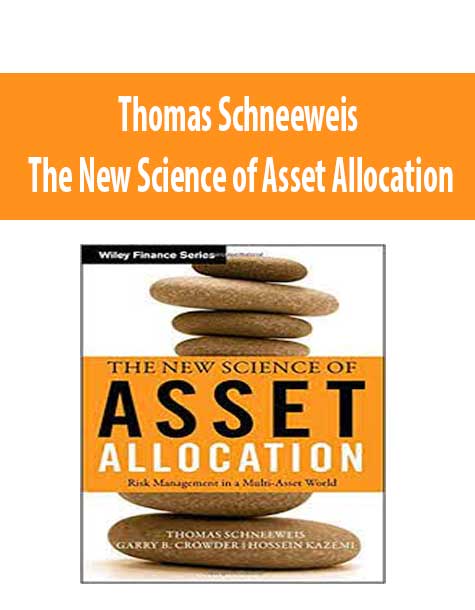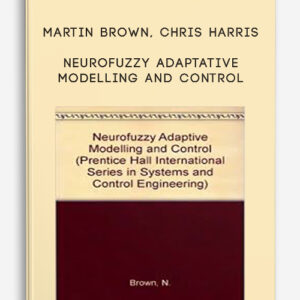THOMAS SCHNEEWEIS – THE NEW SCIENCE OF ASSET ALLOCATION
A feasible asset allocation framework for the post 2008 financial world
Asset allocation has long been a cornerstone of prudent investment management; however, traditional allocation plans failed investors miserably in 2008. Asset allocation still remains an essential part of the investment arena, and through a new approach, you’ll discover how to make it work.
In The New Science of Asset Allocation, authors Thomas Schneeweis, Garry Crowder, and Hossein Kazemi first explore the myths that plague this field then quickly move on to examine how the practice of asset allocation has failed in recent years. They then propose new allocation models that employ liquidity, transparency, and real risk controls across multiple asset classes.
Outlines a new approach to asset allocation in a post-2008 world, where risk seems hidden
The “great manager” problem is examined with solutions on how to capture manager alpha while limiting downside risk
A complete case study is presented that allocates for beta and alpha
Written by an experienced team of industry leaders and academic experts, The New Science of Asset Allocation explains how you can effectively apply this approach to a financial world that continues to change.
Table of Contents
Preface.
Acknowledgments.
Chapter 1 A Brief History of Asset Allocation.
In the Beginning.
A Review of the Capital Asset Pricing Model.
Asset Pricing in Cash and Derivative Markets.
Models of Return and Risk Post-1980.
Asset Allocation in the Modern World.
Product Development: Yesterday, Today, and Tomorrow.
Notes.
Chapter 2 Measuring Risk.
What Is Risk?
Traditional Approaches to Risk Measurement.
Classic Sharpe Ratio.
Other Measures of Risk Assessment.
Portfolio Risk Measures.
Other Measures of Portfolio Risk Measurement.
Value at Risk.
Notes.
Chapter 3 Alpha and Beta, and the Search for a True Measure of Manager Value.
What Is Alpha?
Issues in Alpha and Beta Determination.
Problems in Alpha and Beta Determination.
Multi-Factor Return Estimation: An Example.
Tracking Alternatives in Alpha Determination.
Notes.
Chapter 4 Asset Classes: What They Are And Where To Put Them.
Overview and Limitations of the Existing Asset Allocation Process.
Asset Allocation in Traditional and Alternative Investments: A Road Map.
Historical Return and Risk Attributes and Strategy Allocation.
Traditional Stock/Bond Allocation versus Multi-Asset Allocation.
Risk and Return Comparisons Under Differing Historical Time Periods.
Extreme Market Sensitivity.
Market Segment or Market Sensitivity: Does It Matter?
How New Is New?
Notes.
Chapter 5 Strategic, Tactical, and Dynamic Asset Allocation.
Asset Allocation Optimization Models.
Strategic Asset Allocation.
Tactical Asset Allocation.
Dynamic Asset Allocation.
Notes.
Chapter 6 Core and Satellite Investment: Market/Manager Based Alternatives.
Determining the Appropriate Benchmarks and Groupings.
Sample Allocations.
Core Allocation.
Satellite Investment.
Algorithmic and Discretionary Aspects of Core/Satellite Exposure.
Replication Based Indices.
Peer Group Creation – Style Purity.
Notes.
Chapter 7 Sources of Risk and Return in Alternative Investments.
Asset Class Performance.
Hedge Funds.
Managed Futures (Commodity Trading Advisors).
Private Equity.
Real Estate.
Commodities.
Notes.
Chapter 8 Return and Risk Differences among Similar Asset Class Benchmarks.
Making Sense Out of Traditional Stock and Bond Indices.
Private Equity.
Real Estate.
Alternative REIT Investments Indices.
Commodity Investment.
Hedge Funds.
Investable Manager Based Hedge Fund Indices.
CTA Investment.
Index versus Fund Investment: A Hedge Fund Example.
Notes.
Chapter 9 Risk Budgeting and Asset Allocation.
Process of Risk Management: Multi-Factor Approach.
Process of Risk Management: Volatility Target.
Risk Decomposition of Portfolio.
Risk Management Using Futures.
Risk Management Using Options.
Covered Call.
Long Collar.
Notes.
Chapter 10 Myths of Asset Allocation.
Investor Attitudes, not Economic Information, Drive Asset Values.
Diversification Across Domestic or International Equity Securities is Sufficient.
Historical Security and Index Performance Provides a Simple Means to Forecast Future Excess Risk-Adjusted Returns.
Recent Manager Fund Return Performance Provides the Best Forecast of Future Return.
Superior Managers or Superior Investment Ideas Do Not Exist.
Performance Analytics Provide a Complete Means to Determine Better Performing Managers.
Traditional Assets Reflect “Actual Values” Better Than Alternative Investments.
Stock and Bond Investment Means Investors Have No Derivatives Exposure.
Stock and Bond Investment Removes Investor Concerns as to Leverage.
Given the Efficiency of the Stock and Bond Markets, Managers Provide No Useful Service.
Investors Can Rely on Academics and Investment Professionals to Provide Current Investment Models and Theories.
Alternative Assets Are Riskier Than Equity and Fixed Income Securities.
Alternative Assets Such as Hedge Funds Are Absolute Return Vehicles.
Alternative Investments Such as Hedge Funds Are Unique in Their Investment Strategies.
Hedge Funds Are Black Box Trading Systems Unintelligible to Investors.
Hedge Funds Are Traders, Not Investment Managers.
Alternative Investment Strategies Are So Unique That They Cannot be Replicated.
It Makes Little Difference Which Traditional or Alternative Indices Are Used in an Asset Allocation Model.
Modern Portfolio Theory Is Too Simplistic to Deal with Private Equity, Real Estate, and Hedge Funds.
Notes.
Chapter 11 The Importance of Discretion in Asset Allocation Decisions.
The Why and Wherefore of Asset Allocation Models.
Value of Manager Discretion.
Manager Evaluation and Review: The Due Diligence Process.
Madoff: Due Diligence Gone Wrong or Never Conducted.
Notes.
Chapter 12 Asset Allocation: Where Is It Headed?
An Uncertain Future.
What Is the Definition of Order?
Costs and Benefits.
Today’s Issue.
Possible Governmental and Private Fund Responses to Current Market Concerns.
Note.
Appendix: Risk and Return of Asset Classes and Risk Factors Through Business Cycles.
Glossary: Asset Class Benchmarks.
Bibliography.
About the Authors.
Index.
Author Information
Thomas Schneeweis, PhD, is the Michael and Cheryl Philipp Professor of Finance at the University of Massachusetts, Amherst and is the founding director of the Center for International Securities and Derivatives Markets. He is also the founding editor of the Journal of Alternative Investments, cofounder of the Chartered Alternative Investment Analyst Association, and a founding Director of the Institute for Global Asset and Risk Management. During his almost forty years of investment management experience, he has been associated with the development of alpha transfer and fund replication products, the creation and development of the Zurich Hedge Fund Indices and the Dow Jones Hedge Fund Benchmark Series, as well as being instrumental in the creation of the Bache Commodity Index. Schneeweis publishes widely in the area of investment management and is often quoted in the financial press.
Garry B. Crowder, JD, MBA, is a noted expert in the development and creation of multi-asset portfolio solutions and products. He has designed and implemented asset allocation solutions for leading multinational banks, insurance companies, and family offices. Crowder created and was managing partner of one of the first and largest hedge fund platforms based on managed accounts. In this capacity, he formed and led the team that created the Zurich Hedge Fund Indices and the Dow Jones Hedge Fund Benchmark Series. With over twenty years of investment experience, he is a founding Director of the Institute for Global Asset and Risk Management and has also served in managing director positions at Morgan Stanley Asset Management and Tiger Management LLC.
Hossein Kazemi, PhD, CFA, is regarded as a leader in the area of asset allocation, and has published over thirty academic and practitioner articles in the area of asset pricing and asset allocation. He is a founding partner of Alternative Investment Analytics, LLC, and White Bear Partners, LLC. Kazemi is a professor of finance at the University of Massachusetts, Amherst and is the Associate Director of the Center for International Securities and Derivatives Markets. He is the current Program Director of the Chartered Alternative Analyst Investment Association.
Get Thomas Schneeweis – The New Science of Asset Allocation
Thomas Schneeweis, The New Science of Asset Allocation, Download The New Science of Asset Allocation, Free The New Science of Asset Allocation, The New Science of Asset Allocation Torrent, The New Science of Asset Allocation Review, The New Science of Asset Allocation Groupbuy.
Delivery Method
– After your purchase, you’ll see a View your orders link which goes to the Downloads page. Here, you can download all the files associated with your order.
– Downloads are available once your payment is confirmed, we’ll also send you a download notification email separate from any transaction notification emails you receive from coursesblock.com.
– Since it is a digital copy, our suggestion is to download and save it to your hard drive. In case the link is broken for any reason, please contact us and we will resend the new download link.
– If you cannot find the download link, please don’t worry about that. We will update and notify you as soon as possible at 8:00 AM – 8:00 PM (UTC 8).
Thank You For Shopping With Us!






![[Download Now] Ichimoku Value Cloud Strategy](https://coursesblock.com/wp-content/uploads/2024/10/Ichimoku-Value-Cloud-Strategy-imc-2-300x300.png)
